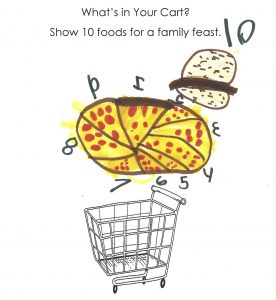Series: Ideas at Work
Counting on Good Food for the Holidays

Traditions around food and feasts provide rich opportunities to connect math at school with children’s experiences at home. From Diwali to Thanksgiving, fall is a season of special meals with loved ones.
 You can read Feast for 10 by Cathryn Falwall to launch a discussion about counting foods at the grocery store. In this book, a family counts from one to ten and then back again as they grocery shop, cook, and set the table to prepare for a family dinner. Children will have their own stories of helping family members prepare favorite dishes to share.
You can read Feast for 10 by Cathryn Falwall to launch a discussion about counting foods at the grocery store. In this book, a family counts from one to ten and then back again as they grocery shop, cook, and set the table to prepare for a family dinner. Children will have their own stories of helping family members prepare favorite dishes to share.
A familiar, math-rich context like grocery shopping promotes children to think about key grade-level concepts. In preschool, children can make a list of foods for a celebration and represent the quantities with drawings—connecting number words and numerals with cardinality.
In kindergarten, children need a lot of opportunities to compose and decompose the benchmark number 10 (CCSS.MATH.CONTENT.K.OA.A.4). So, as illustrated in this first photo, you can ask them to put 10 of their families’ favorite foods in a shopping cart.
 In this second illustration, a child decides that his family will share a pizza. There are 9 slices, and he adds 1 hamburger for his uncle (who doesn’t eat dairy) to make 10.
In this second illustration, a child decides that his family will share a pizza. There are 9 slices, and he adds 1 hamburger for his uncle (who doesn’t eat dairy) to make 10.
Sheila Houston, a first grade teacher at St. Margaret of Scotland School in Chicago, had her students make their own books about grocery shopping for a feast. On each page of the book, the students added a different healthy food to the cart in quantities of 10 and calculated the total number of items in the cart. Students were given different numbers of items to start with to build the important skill of finding 10 more and 10 less than any two-digit number (CCSS.MATH.CONTENT.1.NBT.C.5).
Read one of the student’s books [pdf]
This holiday season, give every child the opportunity to engage with important math concepts in the context of their own lives. Using children’s own stories makes learning math more appetizing!